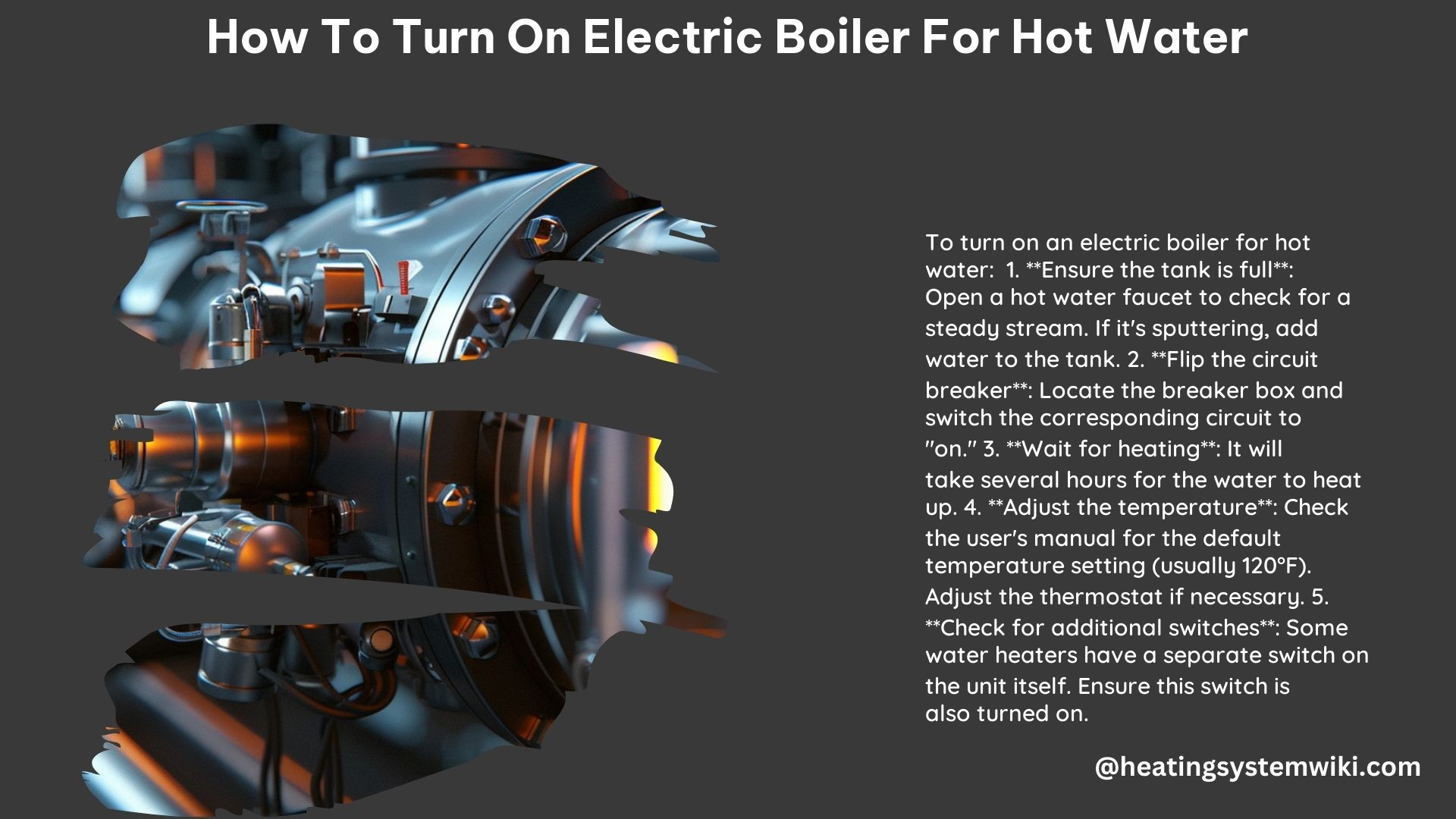Turning on an electric boiler for hot water can be a straightforward process, but it’s essential to follow the proper steps to ensure the safe and efficient operation of your water heating system. This comprehensive guide will walk you through the step-by-step instructions, safety precautions, and technical specifications to help you get your electric boiler up and running smoothly.
Ensure the Tank is Full of Water
Before you can turn on your electric boiler, it’s crucial to ensure that the water tank is fully filled. This step is essential to prevent damage to the heating elements, which can occur if the tank is not adequately filled.
- Check the Water Inlet Valve: Locate the water inlet valve and ensure that it is in the open position, allowing water to flow into the tank.
- Open a Hot Water Faucet: Turn on a hot water faucet near the water heater and check for a steady stream of water. If the water is sputtering or hissing, the tank needs more water.
- Monitor the Water Level: Keep an eye on the water level in the tank and add more water if necessary to maintain a full tank.
Flip the Circuit Breaker

Once you’ve confirmed that the water tank is full, it’s time to turn on the power to the electric boiler.
- Locate the Circuit Breaker: Find the circuit breaker that controls the power to your electric boiler. This may be located in your home’s main electrical panel or near the water heater itself.
- Flip the Breaker to the “On” Position: Firmly flip the circuit breaker to the “on” position. If the breaker is tripped, reset it by first turning it to the “off” position and then back to “on”.
- Verify Power: Check that the power is now flowing to the electric boiler by looking for any indicator lights or displays that may be illuminated.
Check for Electrical Boxes or Disconnects
In addition to the circuit breaker, your electric boiler may have additional electrical components that need to be turned on.
- Locate Electrical Boxes or Disconnects: Look around the water heater for any electrical boxes or disconnects that may have a labeled switch or lever.
- Turn On Electrical Components: If you find any electrical boxes or disconnects, ensure that the switch or lever is in the “on” position.
Reset the Thermostat (If Necessary)
Some electric boilers may have a reset button or switch that needs to be activated if the thermostat has tripped due to overheating or other issues.
- Locate the Reset Button or Switch: Consult your water heater’s user manual to determine the location of the reset button or switch.
- Press the Reset Button: Gently press the reset button to restore the thermostat’s functionality.
Adjust the Temperature (Optional)
Depending on your personal preferences and the recommended settings for your electric boiler, you may want to adjust the water temperature.
- Locate the Temperature Control Knob: Check your water heater’s user manual to see if there is a temperature control knob or dial.
- Set the Desired Temperature: Typically, the recommended temperature setting for most electric water heaters is around 120°F (49°C). However, you may adjust the temperature to your preferred level.
Wait for the Water to Heat Up
Once you’ve completed all the necessary steps, it’s time to wait for the water to heat up.
- Estimated Heating Time: The time it takes for the water to reach the desired temperature can vary depending on the size of the tank and the heating capacity of the electric boiler. Generally, it may take several hours for the water to fully heat up.
- Monitor the Temperature: You can check the water temperature by turning on a hot water faucet and feeling the water flow. Alternatively, some water heaters may have a temperature display or indicator.
Safety Precautions
When working with an electric boiler, it’s essential to prioritize safety. Here are some important precautions to keep in mind:
- Ensure the Tank is Full: Always make sure the water tank is fully filled before turning on the electric boiler to prevent damage to the heating elements.
- Turn Off Power Before Maintenance: Disconnect the power to the water heater before performing any maintenance or repairs to avoid electrical hazards.
- Be Cautious with Electrical Systems: Exercise caution when working with electrical components and gas valves to prevent accidents or injuries.
Technical Specifications
To ensure the proper and safe operation of your electric boiler, it’s important to be aware of the following technical specifications:
- Circuit Breaker Requirement: Electric water heaters typically require a 30-amp circuit breaker to provide the necessary power.
- Recommended Temperature Setting: The recommended temperature setting for most electric water heaters is 120°F (49°C) to prevent scalding and promote energy efficiency.
- Additional Features: Some water heaters may have additional features, such as timers or electronic controls, that need to be properly set or activated.
By following the step-by-step instructions and adhering to the safety precautions and technical specifications outlined in this guide, you can confidently turn on your electric boiler and enjoy a reliable supply of hot water in your home.
